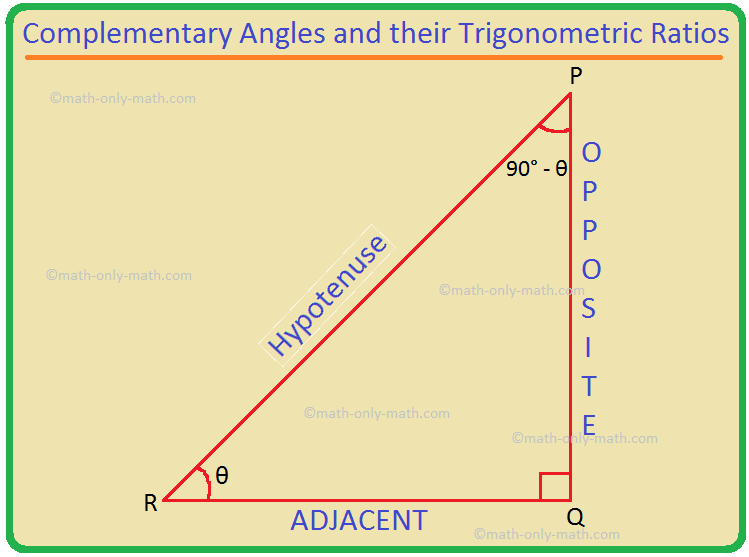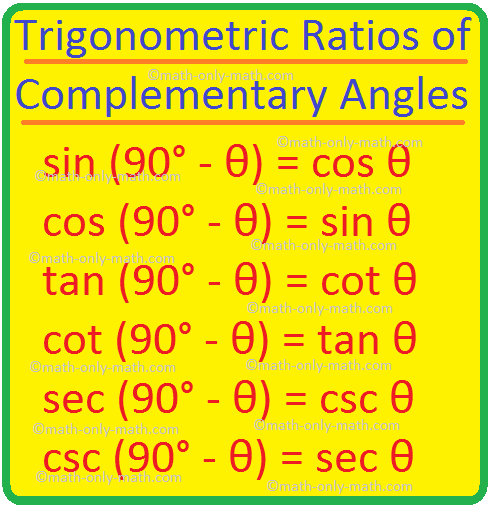Subscribe to our ▶️ YouTube channel 🔴 for the latest videos, updates, and tips.
Trigonometric Ratios of Complementary Angles
Complementary angles and their trigonometric ratios:
We know from geometry if the sum of two angles is 90°, then one angle is called the complement of the other.
Two angles A and B are complementary if A + B = 90°. So, B = 90° - A.
For example, as 30° + 60° = 90°, 60° is called the complement of 30° and conversely, 30° is called the complement of 60°.
Thus 27° is the complement of 60°; 43.5° is the complement of 46.5° etc.
Thus in general, (90° - θ) and θ are complementary angles. Trigonometric ratios of (90° - θ) are convertible to trigonometric ratios of θ.
Trigonometric Ratios of 90° - θ in Terms of Trigonometric ratios of θ
Let us see how we can find the trigonometrical ratios of 90° - θ, if we know those of θ°.
Let PQR be a right-angled triangle in which ∠Q is the right angle.
Let ∠PRQ = θ. Then, ∠QPR = 180° - (90° + θ) = 90° - θ.
1. sin (90° - θ) = cos θ
Here, sin (90° - θ) = \(\frac{QR}{PR}\) and cos θ = \(\frac{QR}{PR}\)
Therefore, sin (90° - θ) = cos θ.
2. cos (90° - θ) = sin θ
Here, cos (90° - θ) = \(\frac{PQ}{PR}\) and sin θ = \(\frac{PQ}{PR}\)
Therefore, cos (90° - θ) = sin θ.
3. tan (90° - θ) = cot θ
Here, tan (90° - θ) = \(\frac{QR}{PQ}\) and cot θ = \(\frac{QR}{PQ}\)
Therefore, tan (90° - θ) = cot θ.
4. csc (90° - θ) = sec θ
Here, csc (90° - θ) = \(\frac{PR}{QR}\) and sec θ = \(\frac{PR}{QR}\)
Therefore, csc (90° - θ) = sec θ
5. sec (90° - θ) = csc θ
Here, sec (90° - θ) = \(\frac{PR}{PQ}\) and csc θ = \(\frac{PR}{PQ}\)
Therefore, sec (90° - θ) = csc θ.
6. cot (90° - θ) = tan θ
Here, cot (90° - θ) = \(\frac{PQ}{QR}\) and tan θ = \(\frac{PQ}{QR}\)
Therefore, cot (90° - θ) = tan θ.
Thus, we have the following conversions of trigonometric ratios of (90° - θ) in terms of trigonometric ratios of θ.
|
sin (90° - θ) = cos θ cos (90° - θ) = sin θ |
tan (90° - θ) = cot θ cot (90° - θ) = tan θ |
sec (90° - θ) = csc θ csc (90° - θ) = sec θ |
For example, cos 37° can be expressed as sine of the complementary angle of 37° because
cos 37° = cos (90° - 53°) = sin 53°.
Note: The measure of an angle can be expressed in degrees (°) as well as in radians. The measure of an angle is π radians (where π is 3.14, approximately) if its measure in degrees is 180°. Thus, 180° = π radians. This is also written as 180° = π.
Therefore, 1° = \(\frac{π}{180}\)
30° = \(\frac{π}{6}\)
45° = \(\frac{π}{4}\)
60° = \(\frac{π}{3}\)
90° = \(\frac{π}{2}\), etc.
Therefore, we can write sin (90° - β) = sin (\(\frac{π}{2}\) – β) = cos β
cos (90° - β) = cos (\(\frac{π}{2}\) – β) = sin β
tan (90° - β) = tan (\(\frac{π}{2}\) – β) = cot β
csc (90° - β) = csc (\(\frac{π}{2}\) – β) = sec β
sec (90° - β) = sec (\(\frac{π}{2}\) – β) = csc β
cot (90° - β) = cot (\(\frac{π}{2}\) – β) = tan β.
The values of trigonometrical ratios of 30° and 60°, which are complementary angles are compared below. This will help us to have a clear understanding of the relations shown before.
sin 30° = cos 60° = \(\frac{1}{2}\)
cos 30° = sin 60° = \(\frac{\sqrt{3}}{2}\)
tan 30° = cot 60° = \(\frac{\sqrt{3}}{3}\)
csc 30° = sec 60° = 2
sec 30° = csc 60° = \(\frac{2\sqrt{3}}{3}\)
cot 30° = tan 60° = \(\sqrt{3}\)
Similarly, from the complementary angles formulae we get
sin 45° = cos 45° = \(\frac{\sqrt{2}}{2}\)
tan 45° = cot 45° = 1
csc 45 = sec 45° = \(\sqrt{2}\)
tan 45° = cot 45° = 1
Again,
sin 90° = cos 0° = 1
cos 90° = sin 0° = 0
Problems on Trigonometric Ratios of Complementary Angles
Problems on evaluation using trigonometric ratios of complementary angles
1. Evaluate without using trigonometric table: \(\frac{sin 25°}{2 ∙ cos 65°}\)
Solution:
\(\frac{sin 25°}{2 ∙ cos 65°}\)
= \(\frac{sin 25°}{2 ∙ cos (90° - 25°)}\)
= \(\frac{sin 25°}{2 ∙ sin 25°}\); [since, cos (90° - θ) = sin θ]
= \(\frac{1}{2}\).
2. Evaluate without using trigonometric table: tan 38° ∙ tan 52°
Solution:
tan 38° ∙ tan 52°
= tan 38° ∙ tan (90° - 38°)
= tan 38° ∙ cot 38°; [Since, tan (90° - θ) = cot θ]
= tan 38° ∙ \(\frac{1}{tan 38°}\)
= 1.
3. Evaluate without using trigonometric table: \(\frac{sin 67°}{cos 23°}\) - \(\frac{sec 12°}{csc 78°}\)
Solution:
\(\frac{sin 67°}{cos 23°}\) - \(\frac{sec 12°}{csc 78°}\)
= \(\frac{sin 67°}{cos (90° - 67°)}\) - \(\frac{sec 12°}{csc (90° - 12°)}\)
= \(\frac{sin 67°}{cos (90° - 67°)}\) - \(\frac{sec 12°}{csc (90° - 12°)}\)
= \(\frac{sin 67°}{sin 67°}\) - \(\frac{sec 12°}{sec 12°}\)
[Since, cos (90° - θ) = sin θ and csc (90° - θ) = sec θ]
= 1 - 1
= 0.
4. If cos 39° = \(\frac{x}{\sqrt{x^{2} + y^{2}}}\), what is the value of tan 51°?
Solution:
Given that cos 39° = \(\frac{x}{\sqrt{x^{2} + y^{2}}}\)
Therefore, sin2 39° = 1 - \(\frac{x^{2}}{x^{2} + y^{2}}\)
= \(\frac{x^{2} + y^{2} - x^{2}}{x^{2} + y^{2}}\)
= \(\frac{y^{2}}{x^{2} + y^{2}}\)
Therefore, sin 39° = \(\frac{y}{\sqrt{x^{2} + y^{2}}}\), (negative value is not acceptable)
Now, tan 51° = tan (90° - 39°)
= cot 39°
= \(\frac{cos 39°}{sin 39°}\)
= cos 39° ÷ sin 39°
= \(\frac{x}{\sqrt{x^{2} + y^{2}}}\) ÷ \(\frac{y}{\sqrt{x^{2} + y^{2}}}\)
= \(\frac{x}{y}\).
5. If cos 37° = x then find the value of tan 53°.
Solution:
tan 53°
= tan (90° - 37°)
= cot 37°; [Since, tan (90° - θ) = cot θ]
= \(\frac{cos 37°}{sin 37°}\)
= \(\frac{x}{sin 37°}\) ................ (i)
Now, sin2 37° = 1 - cos2 37°; [since, 1 - cos2 θ = sin2 θ]
Therefore, sin 37° = \(\sqrt{1 - cos^{2} 37°}\)
= \(\sqrt{1 - x^{2}}\)
Therefore, from (i), tan 53° = \(\frac{x}{\sqrt{1 - x^{2}}}\).
6. If sec ϕ = csc β and 0° < (ϕ, β) < 90°, find the value of sin (ϕ + β).
Solution:
sec ϕ = csc β
⟹ \(\frac{1}{cos ϕ}\) = \(\frac{1}{sin β}\)
⟹ cos ϕ = sin β
⟹ cos ϕ = cos (90° - β)
⟹ ϕ = 90° - β
⟹ ϕ + β = 90°
Therefore, sin (ϕ + β) = sin 90° = 1.
7. Find the value of sin2 15° + sin2 25° + sin2 33° + sin2 57° + sin2 65° + sin2 75°.
Solution:
sin2 (90° - 75°) + sin2 (90° - 65°) + sin2 (90° - 57°) + sin2 57° + sin2 65° + sin2 75°.
= cos2 75° + cos2 65° + cos2 57° + sin2 57° + sin2 65° + sin2 75°.
= (sin2 57° + cos2 75°) + (sin2 65° + cos2 65°) + (sin2 57° + cos2 57°)
= 1 + 1 + 1; [Since, sin2 θ + cos2 θ = 1]
= 3.
8. If tan 49° ∙ cot (90° - θ) = 1, find θ.
Solution:
tan 49° ∙ cot (90° - θ) = 1
⟹ tan 49° ∙ tan θ = 1; [Since, cot (90° - θ) = tan θ]
⟹ tan θ = \(\frac{1}{tan 49°}\)
⟹ tan θ = cot 49°
⟹ tan θ = cot (90° - 41°)
⟹ tan θ = tan 41°
⟹ θ = 41°
Therefore, θ = tan 41°.
Problems on establishing equality using trigonometric ratios of complementary angles
9. Prove that sin 33° cos 77° = cos 57° sin 13°
Solution:
LHS = sin 33° cos 77°
= sin (90° - 57°) cos (90° - 13°)
= cos 57° sin 13°
= RHS. (Proved).
10. Prove that tan 11° + cot 63° = tan 27° + cot 79°
Solution:
LHS = tan 11° + cot 63°
= tan (90° - 79°) + cot (90° - 27°)
= cot 79° + tan 27°
= tan 27° + cot 79°
= RHS. (Proved).
Problems on establishing identities and simplification using trigonometric ratios of complementary angles
11. If P and Q are two complementary angles, show that
(sin P + sin Q)2 = 1 + 2 sin P cos P
Solution:
Since P are Q are complementary angles,
Therefore, sin Q = sin (90° - P) = cos P
Therefore, (sin P + sin Q)2 = (sin P + cos P)2
= sin2 P + cos2 P + 2 sin P cos P
= (sin2 P + cos2 P) + 2 sin P cos P
= 1 + 2 sin P cos P
12. Simplify: \(\frac{sin (\frac{π}{2} - θ) ∙ cot (\frac{π}{2} - θ)}{sin θ}\)
Solution:
\(\frac{sin (\frac{π}{2} - θ) ∙ cot (\frac{π}{2} - θ)}{sin θ}\)
= \(\frac{cos θ ∙ tan θ}{sin θ}\), [Since sin (\(\frac{π}{2}\) - θ) = sin (90° - θ) = cos θ and cot (\(\frac{π}{2}\) - θ) = cot (90° - θ) = tan θ]
= \(\frac{cos θ ∙ \frac{sin θ}{cos θ}}{sin θ}\)
= \(\frac{sin θ}{sin θ}\)
= 1.
13. Prove that, sin2 7° + sin2 83°
Solution:
sin 83° = sin (90° - 7°)
= cos 7°; [since, sin (90° - θ) = cos θ]
LHS = sin2 7° + sin2 83°
= sin2 7° + cos2 7°, [Since, sin 83° = cos 7°]
= 1 = RHS (Proved).
14. In a ∆PQR, prove that sin \(\frac{P + Q}{2}\) = cos \(\frac{R}{2}\).
Solution:
We know that sum of the three angles of a triangle is 180°.
i,e., P + Q + R = 180°
⟹ P + Q = 180° - R
Now,
LHS = sin \(\frac{P + Q}{2}\)
= sin \(\frac{180° - R}{2}\)
= sin (90° - \(\frac{R}{2}\))
= cos \(\frac{R}{2}\) = RHS (Proved).
15. Prove that tan 15° + tan 75° = \(\frac{sec^{2} 15°}{\sqrt{sec^{2} 15° - 1}}\).
Solution:
LHS = tan 15° + tan (90° - 15°)
= tan 15° + cot 15°
= tan 15° + \(\frac{1}{tan 15°}\)
= \(\frac{tan^{2} 15° + 1}{tan 15°}\)
= \(\frac{sec^{2} 15°}{\sqrt{sec^{2} 15° - 1}}\) = RHS (Proved).
Learn more about Trigonometrical Ratios of Complementary Angles.
From Trigonometric Ratios of Complementary Angles to HOME PAGE
Didn't find what you were looking for? Or want to know more information about Math Only Math. Use this Google Search to find what you need.




New! Comments
Have your say about what you just read! Leave me a comment in the box below. Ask a Question or Answer a Question.